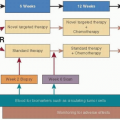There is general agreement that combinations of systemic and local/regional therapies represent the standard of care for all patients with LABC.
are often inaccurate, and there is substantial interindividual variation among examiners (23). Therefore, imaging methods are often used to more reliably document extent of disease (24). The combination of physical examination with either mammography or ultrasound gives measurements that closely approach those achieved by histopathology, and it reduces error rates in serial monitoring of response to systemic therapy (24). MRI may also be used to determine extent of disease (25). The determination of clinical complete remission requires that no residual disease be present by physical examination and by imaging (mammography and/or ultrasound) in the breast or regional lymph nodes (17). Even following these criteria, only half to two-thirds of patients thought to have a clinical complete remission are found to have a pathologic complete remission (i.e., no residual disease) (17, 18, 20, 21, 24). Furthermore, a third of patients with no residual disease by histologic examination will have residual clinical or imaging abnormalities that preclude the diagnosis of clinical complete remission. Patients who achieve a histologically documented complete remission have a markedly improved long-term prognosis compared with patients who achieve incomplete or no responses (17, 21, 26). Furthermore, these patients are often excellent candidates for breast-conserving strategies, with or without surgical intervention (27). In recent years, in addition to refinements to the sequential evaluation of extent of disease during therapy utilizing mammography, sonography, and MRI, positron emission tomography (PET) has been evaluated. Several authors have reported that not only does PET (usually in combination with CT, PET/CT) identify metastatic lesions not found by other imaging modalities (28) but also it is a very sensitive tool to monitor the functional status of the tumor. Thus, changes in PET imaging, such as marked reductions in standardized uptake values, are under evaluation for early determination of response to neoadjuvant systemic therapy (29).
were confirmed by a larger randomized trial that included 235 patients with HER-2/neu-positive primary breast cancer (47). A large, multicenter confirmatory study has completed accrual patients with T2 and T3, HER-2-positive breast cancer (ACOSOG protocol Z1041). Gianni and collaborators also reported the initial results of a four-arm randomized trial comparing neoadjuvant docetaxel plus trastuzumab with docetaxel plus pertuzumab, docetaxel plus both antibodies, or the two antibodies without chemotherapy (48). Pathological complete remission rates were 31%, 23%, 49%, and 18%, for the four arms, respectively, indicating that combining the two antibodies with chemotherapy provides the best result, while the two antibodies without chemotherapy were able to eradicate the primary tumor in almost 20% of patients.
TABLE 58-1 Randomized Phase III Studies Comparing Anthracycline- and Taxane-Containing Regimens with Anthracycline-Containing Combinations without Taxanes | ||||||||||||||||||||||||||||||||||||||||||||||||||||||||||||||||||
|---|---|---|---|---|---|---|---|---|---|---|---|---|---|---|---|---|---|---|---|---|---|---|---|---|---|---|---|---|---|---|---|---|---|---|---|---|---|---|---|---|---|---|---|---|---|---|---|---|---|---|---|---|---|---|---|---|---|---|---|---|---|---|---|---|---|---|
| ||||||||||||||||||||||||||||||||||||||||||||||||||||||||||||||||||
TABLE 58-2 Effective and Well-Tolerated Induction Chemotherapy Regimens | |||||||||||||||||||||||||||||||||||||||||||||||||||||||||||||||||||||||||||||||||||||||||||||||||||||||||||||||||||||||||
|---|---|---|---|---|---|---|---|---|---|---|---|---|---|---|---|---|---|---|---|---|---|---|---|---|---|---|---|---|---|---|---|---|---|---|---|---|---|---|---|---|---|---|---|---|---|---|---|---|---|---|---|---|---|---|---|---|---|---|---|---|---|---|---|---|---|---|---|---|---|---|---|---|---|---|---|---|---|---|---|---|---|---|---|---|---|---|---|---|---|---|---|---|---|---|---|---|---|---|---|---|---|---|---|---|---|---|---|---|---|---|---|---|---|---|---|---|---|---|---|---|---|
| |||||||||||||||||||||||||||||||||||||||||||||||||||||||||||||||||||||||||||||||||||||||||||||||||||||||||||||||||||||||||
results suggested that neoadjuvant endocrine therapy was therapeutically effective and produced marked reduction in tumor volume in 40% to 60% of patients. A significant minority of tumors progressed during neoadjuvant endocrine therapy; thus, close monitoring is required so that early progressors are identified promptly and appropriate regional therapy (or crossover to chemotherapy) can be implemented. Several studies also concluded that tamoxifen alone was insufficient therapy for patients with primary and locally advanced breast cancer, and that appropriate surgery and/or radiation therapy was needed for optimal local and systemic control (51, 52). Endocrine therapy should be restricted to patients with hormone receptor-positive breast cancer. More recent trials compared selective aromatase inhibitors with drugs in the same family or with tamoxifen (53). Greater antitumor efficacy was observed with aromatase inhibitors compared to tamoxifen (53). In general, response to neoadjuvant endocrine therapy occurs in 35% to 50% of patients with hormone receptor-positive breast cancer, but fewer than 5% achieve pCR. Response rates to neoadjuvant endocrine therapies in this setting are lower than response rates to anthracycline/taxane based chemotherapy in unselected patients with LABC (52); pCR rates with neoadjuvant chemotherapy for patients with ER+ breast cancer are observed in 5% to 14%, several-fold lower than for patients with ER- breast cancer. Early progression is observed more frequently after neoadjuvant endocrine therapy (12% to 17%) (53) than after neoadjuvant chemotherapy (5% to 10%) (6). The poor prognosis for patients with LABC indicates that all treatment modalities are needed for optimal results, so all patients with positive estrogen and/or progesterone receptor assays should receive adjuvant endocrine treatment as part of multidisciplinary therapy. Whether there is a subset of patients with hormone receptor-positive LABC that does not benefit from, and therefore does not require, NACT is under active investigation.
Stay updated, free articles. Join our Telegram channel

Full access? Get Clinical Tree







